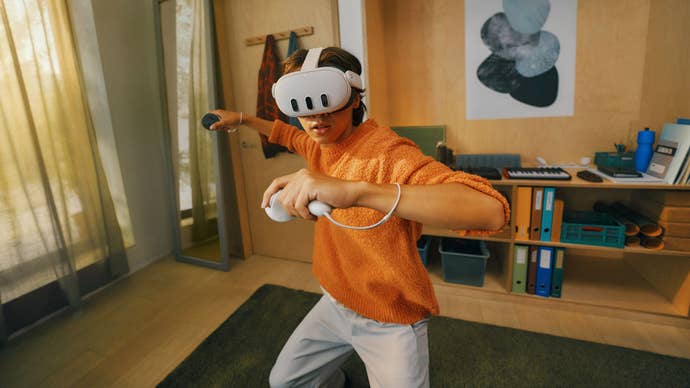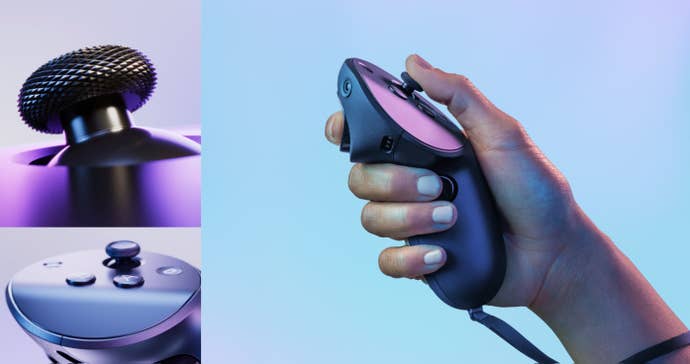Products You May Like
It’s been out for a little while now, but I didn’t want to rush to a review and a verdict on the Meta Quest 3. The reason behind that is pretty simple: I cooled on the previous generation pretty quickly. It impressed out of the gate, but I quickly drifted away from the technology. It struggled to hold my interest. I wanted to see how the Quest 3 held up over a longer period of time – so I held off on writing it up.
When it comes to the world of Virtual Reality, I admit I’m a bit of a Goldilocks.
Like, part of the problem of VR for me is the faff. I’m a specs goblin, and love to run things in high quality. I have a super high-end PC. But the idea of messing about with the setup stuff for PC VR whenever I want to use it, or leaving stuff set up in a maze of wiring, immediately turns me off using PC VR regularly. In addition, I can’t quite justify spending the outlay on the best PC headsets when I know VR is currently an aside rather than the bulk of my gaming time. By that logic, the wireless headsets like the Quest should be the ones for me – but then I miser over the visual fidelity and the weight burden.
Like Goldilocks, I don’t want too much of one way or too much of the other: I want it to be ‘just right’. Threading that needle has proved difficult for pretty much any of the headsets I’ve owned.
In terms of sheer graphical heft, the Meta Quest 3 isn’t going to be rivaling my 4090 any time soon, obviously – but it is a decent improvement over the previous-generation. It’s largely about small updates, but many of these little things add up to a lot. One in particular makes a world of difference.
The headline of this article has a double meaning, you see. The Meta Quest 3 retains the streamlined all-in-one setup of the previous Quest headsets – which eliminates the pain that comes with chaining cables to your PC or console, or the indignity of slipping your phone into some stupid cradle that straps to your face. But with an all-in-one solution comes challenges – like how the headset itself has to house all the tech. It’s here where my neck begins to ache.
The first and second generations of the Quest, both of which I owned and used, were great big things. They had significant protrusions in front of the eyes which housed cameras, tech, speakers – and, of course, the ocular component – lenses, screens, the things that allow the VR illusion to feel so close to reality. These things are big. Or rather – were big.
The new revolution for the Meta Quest 3 are known as pancake lenses – an evocative name that gets the point of what they do differently across. They’re very slender lenses, basically – which lops a huge amount of the depth off the front of the headset.
These new lenses are a long way from as flat as the name suggests, and the weight difference between the Quest 3 and 2 is negligible (the 3 is just 15 grams or 3% lighter) – but the difference feels far greater. This may be because the weight is spread over less of an area, leading for the whole thing to feel less heavy on your face. I don’t know, honestly – I’m not the type of critic to do the super deep dives on that technical element. I just know it feels better, and I can play it for far longer without slipping into discomfort.
Where I did start to get discomfort, it was because I am bespectacled – but this can be remedied if you’re willing to cough up the dough to buy prescription lenses for the device. I’ve not done that yet, but it’s to the Quest 3’s credit that I feel like I can make a case with myself for coughing up the extra for the lenses – as my glasses are now probably the greatest barrier to even longer play sessions.

Essentially, when I’m wearing the Meta Quest 3 I feel a little more natural; I don’t feel like I’m strutting around with a great big box strapped to my face. As a bonus, the pancake lenses also offer a greater sense of clarity and immersion. There’s more of an ‘edge-to-edge’ feel, which greatly ups the illusion. Where the previous iterations of Quest could sometimes feel like you were gazing into an extremely convincing portal to another world, the presentation here is greatly improved by an extra 30 degrees on its field-of-view.
The other big change that removes a great deal of my past frustration is the improvement to the pass-through visuals. Now, if you need to see the room around you – to see what the dog is barking at, or to locate a biscuit to shovel into your virtual gob, or to share one of those biscuits with the dog, for instance – you can.
If you’ve not played the previous generation, let me assure you – the Quest 2’s pass-through was a monochrome nightmare. It was difficult to see much of anything; just enough to avoid tripping over stuff, or to set a ‘boundary’ that warns you if you’re straying too close to a precious yet precariously-placed family heirloom mid-game. In the Quest 3, it’s higher resolution, color, and doesn’t fizz like a low-quality eighties TV signal.
Don’t get me wrong – it’s not perfect. I’ve managed to check my phone through the Quest 3 pass-through in a pinch, but the resolution is not that high. But it’s high enough: it’s edging into that Goldilocks sweet spot where I can do basic tasks with the headset still in place, which removes the pain in the neck of having to adjust straps and mess around to get in and out of it. I wouldn’t exactly recommend making a cup of tea and dealing with boiling water while still inside the confines of the Quest 3 – but, well, I’ve done it. Which says a lot. I probably wouldn’t answer the door in it, because I think these things still roundly make you look like a tosser. But it’s progress.

The level of comfort these pancake lenses offer isn’t actually technically new – but previously they were available on the Meta Quest Pro, which is the higher-end headset with a higher-end price, starting at the better part of double the price of the Quest 3 even if you can score a deal. Like I said before, it’s the Goldilocks Gambit; not too expensive, not too crap. Just right.
Obviously you need the software to match, both in terms of games and a user experience – and that is something I’d like to return to as I continue to live with this device. But as an opening salvo, the sheer improvement in the comfort and convenience of the headset is a strong start. And it’s the closest ever VR offering to hitting that ‘just right’ sweet spot for me.
